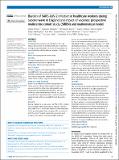Burden of SARS-CoV-2 infection in healthcare workers during second wave in England and impact of vaccines : prospective multicentre cohort study (SIREN) and mathematical model
Abstract
OBJECTIVE: To describe the incidence of, risk factors for, and impact of vaccines on primary SARS-CoV-2 infection during the second wave of the covid-19 pandemic in susceptible hospital healthcare workers in England. DESIGN: Multicentre prospective cohort study. SETTING: National Health Service secondary care health organisations (trusts) in England between 1 September 2020 and 30 April 2021. PARTICIPANTS: Clinical, support, and administrative staff enrolled in the SARS-CoV-2 Immunity and Reinfection Evaluation (SIREN) study with no evidence of previous infection. Vaccination status was obtained from national covid-19 vaccination registries and self-reported. MAIN OUTCOME MEASURE: SARS-CoV-2 infection confirmed by polymerase chain reaction. Mixed effects logistic regression was conducted to determine demographic and occupational risk factors for infection, and an individual based mathematical model was used to predict how large the burden could have been if vaccines had not been available from 8 December 2020 . RESULTS: During England's second wave, 12.9% (2353/18 284) of susceptible SIREN participants became infected with SARS-CoV-2. Infections peaked in late December 2020 and decreased from January 2021, concurrent with the cohort's rapid vaccination coverage and a national lockdown. In multivariable analysis, factors increasing the likelihood of infection in the second wave were being under 25 years old (20.3% (132/651); adjusted odds ratio 1.35, 95% confidence interval 1.07 to 1.69), living in a large household (15.8% (282/1781); 1.54, 1.23 to 1.94, for participants from households of five or more people), having frequent exposure to patients with covid-19 (19.2% (723/3762); 1.79, 1.56 to 2.06, for participants with exposure every shift), working in an emergency department or inpatient ward setting (20.8% (386/1855); 1.76, 1.45 to 2.14), and being a healthcare assistant (18.1% (267/1479); 1.43, 1.16 to 1.77). Time to first vaccination emerged as being strongly associated with infection (P<0.001), with each additional day multiplying a participant's adjusted odds ratio by 1.02. Mathematical model simulations indicated that an additional 9.9% of all patient facing hospital healthcare workers would have been infected were it not for the rapid vaccination coverage. CONCLUSIONS: The rapid covid-19 vaccine rollout from December 2020 averted infection in a large proportion of hospital healthcare workers in England: without vaccines, second wave infections could have been 69% higher. With booster vaccinations being needed for adequate protection from the omicron variant, and perhaps the need for further boosters for future variants, ensuring equitable delivery to healthcare workers is essential. The findings also highlight occupational risk factors that persisted in healthcare workers despite vaccine rollout; a greater understanding of the transmission dynamics responsible for these is needed to help to optimise the infection prevention and control policies that protect healthcare workers from infection and therefore to support staffing levels and maintain healthcare provision. TRIAL REGISTRATION: ISRCTN registry ISRCTN11041050.
Citation
Pople , D , Monk , E J M , Evans , S , Foulkes , S , Islam , J , Wellington , E , Atti , A , Hope , R , Robotham , J , Hopkins , S , Brown , C S , Hall , V J , SIREN Study Group & Dhasmana , D J 2022 , ' Burden of SARS-CoV-2 infection in healthcare workers during second wave in England and impact of vaccines : prospective multicentre cohort study (SIREN) and mathematical model ' , BMJ , vol. 378 , e070379 . https://doi.org/10.1136/bmj-2022-070379
Publication
BMJ
Status
Peer reviewed
ISSN
0959-8138Type
Journal article
Description
Funding: The study is funded by the Department of Health and Social Care (DHSC) and UK Health Security Agency (UKHSA; formally Public Health England), with contributions from the governments of Northern Ireland, Scotland, and Wales. Funding was also provided by the National Institute for Health Research (NIHR) as an Urgent Public Health Priority Study and through the Health Protection Research Unit in Healthcare Associated Infections and Antimicrobial Resistance (NIHR200915), a partnership between UKHSA and the University of Oxford.Collections
Items in the St Andrews Research Repository are protected by copyright, with all rights reserved, unless otherwise indicated.

